Yekun Chai
Curiosity-Driven Reinforcement Learning from Human Feedback
Jan 20, 2025



Abstract:Reinforcement learning from human feedback (RLHF) has proven effective in aligning large language models (LLMs) with human preferences, but often at the cost of reduced output diversity. This trade-off between diversity and alignment quality remains a significant challenge. Drawing inspiration from curiosity-driven exploration in reinforcement learning, we introduce curiosity-driven RLHF (CD-RLHF), a framework that incorporates intrinsic rewards for novel states, alongside traditional sparse extrinsic rewards, to optimize both output diversity and alignment quality. We demonstrate the effectiveness of CD-RLHF through extensive experiments on a range of tasks, including text summarization and instruction following. Our approach achieves significant gains in diversity on multiple diversity-oriented metrics while maintaining alignment with human preferences comparable to standard RLHF. We make our code publicly available at https://github.com/ernie-research/CD-RLHF.
MA-RLHF: Reinforcement Learning from Human Feedback with Macro Actions
Oct 03, 2024



Abstract:Reinforcement learning from human feedback (RLHF) has demonstrated effectiveness in aligning large language models (LLMs) with human preferences. However, token-level RLHF suffers from the credit assignment problem over long sequences, where delayed rewards make it challenging for the model to discern which actions contributed to successful outcomes. This hinders learning efficiency and slows convergence. In this paper, we propose MA-RLHF, a simple yet effective RLHF framework that incorporates macro actions -- sequences of tokens or higher-level language constructs -- into the learning process. By operating at this higher level of abstraction, our approach reduces the temporal distance between actions and rewards, facilitating faster and more accurate credit assignment. This results in more stable policy gradient estimates and enhances learning efficiency within each episode, all without increasing computational complexity during training or inference. We validate our approach through extensive experiments across various model sizes and tasks, including text summarization, dialogue generation, question answering, and program synthesis. Our method achieves substantial performance improvements over standard RLHF, with performance gains of up to 30% in text summarization and code generation, 18% in dialogue, and 8% in question answering tasks. Notably, our approach reaches parity with vanilla RLHF 1.7x to 2x faster in terms of training time and continues to outperform it with further training. We will make our code and data publicly available at https://github.com/ernie-research/MA-RLHF .
Tokenization Falling Short: The Curse of Tokenization
Jun 17, 2024Abstract:Language models typically tokenize raw text into sequences of subword identifiers from a predefined vocabulary, a process inherently sensitive to typographical errors, length variations, and largely oblivious to the internal structure of tokens-issues we term the curse of tokenization. In this study, we delve into these drawbacks and demonstrate that large language models (LLMs) remain susceptible to these problems. This study systematically investigates these challenges and their impact on LLMs through three critical research questions: (1) complex problem solving, (2) token structure probing, and (3) resilience to typographical variation. Our findings reveal that scaling model parameters can mitigate the issue of tokenization; however, LLMs still suffer from biases induced by typos and other text format variations. Our experiments show that subword regularization such as BPE-dropout can mitigate this issue. We will release our code and data to facilitate further research.
Dual Modalities of Text: Visual and Textual Generative Pre-training
Apr 17, 2024



Abstract:Harnessing visual texts represents a burgeoning frontier in the evolution of language modeling. In this paper, we introduce a novel pre-training framework for a suite of pixel-based autoregressive language models, pre-training on a corpus of over 400 million documents rendered as RGB images. Our approach is characterized by a dual-modality training regimen, engaging both visual data through next patch prediction with a regression head and textual data via next token prediction with a classification head. This study is particularly focused on investigating the synergistic interplay between visual and textual modalities of language. Our comprehensive evaluation across a diverse array of benchmarks reveals that the confluence of visual and textual data substantially augments the efficacy of pixel-based language models. Notably, our findings show that a unidirectional pixel-based model, devoid of textual data during training, can match the performance levels of advanced bidirectional pixel-based models on various language understanding benchmarks. This work highlights the considerable untapped potential of integrating visual and textual information for language modeling purposes. We will release our code, data, and checkpoints to inspire further research advancement.
On Training Data Influence of GPT Models
Apr 11, 2024



Abstract:Amidst the rapid advancements in generative language models, the investigation of how training data shapes the performance of GPT models is still emerging. This paper presents GPTfluence, a novel approach that leverages a featurized simulation to assess the impact of training examples on the training dynamics of GPT models. Our approach not only traces the influence of individual training instances on performance trajectories, such as loss and other key metrics, on targeted test points but also enables a comprehensive comparison with existing methods across various training scenarios in GPT models, ranging from 14 million to 2.8 billion parameters, across a range of downstream tasks. Contrary to earlier methods that struggle with generalization to new data, GPTfluence introduces a parameterized simulation of training dynamics, demonstrating robust generalization capabilities to unseen training data. This adaptability is evident across both fine-tuning and instruction-tuning scenarios, spanning tasks in natural language understanding and generation. We will make our code and data publicly available.
Aurora-M: The First Open Source Multilingual Language Model Red-teamed according to the U.S. Executive Order
Mar 30, 2024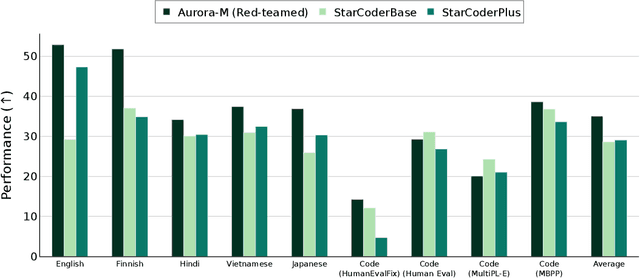

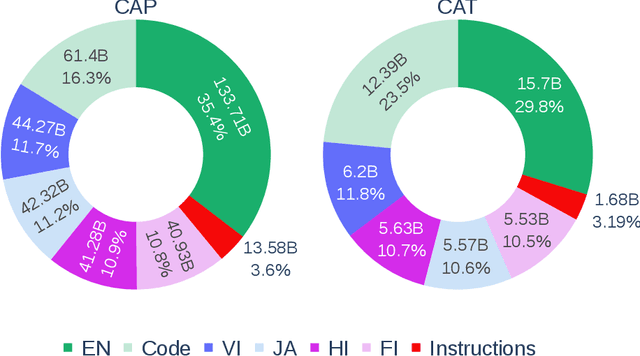

Abstract:Pretrained language models underpin several AI applications, but their high computational cost for training limits accessibility. Initiatives such as BLOOM and StarCoder aim to democratize access to pretrained models for collaborative community development. However, such existing models face challenges: limited multilingual capabilities, continual pretraining causing catastrophic forgetting, whereas pretraining from scratch is computationally expensive, and compliance with AI safety and development laws. This paper presents Aurora-M, a 15B parameter multilingual open-source model trained on English, Finnish, Hindi, Japanese, Vietnamese, and code. Continually pretrained from StarCoderPlus on 435 billion additional tokens, Aurora-M surpasses 2 trillion tokens in total training token count. It is the first open-source multilingual model fine-tuned on human-reviewed safety instructions, thus aligning its development not only with conventional red-teaming considerations, but also with the specific concerns articulated in the Biden-Harris Executive Order on the Safe, Secure, and Trustworthy Development and Use of Artificial Intelligence. Aurora-M is rigorously evaluated across various tasks and languages, demonstrating robustness against catastrophic forgetting and outperforming alternatives in multilingual settings, particularly in safety evaluations. To promote responsible open-source LLM development, Aurora-M and its variants are released at https://huggingface.co/collections/aurora-m/aurora-m-models-65fdfdff62471e09812f5407 .
StarCoder 2 and The Stack v2: The Next Generation
Feb 29, 2024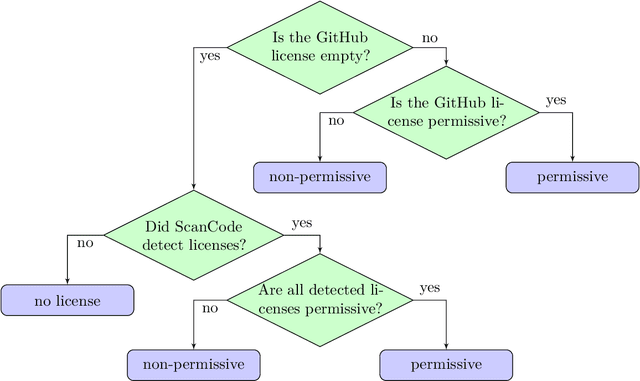
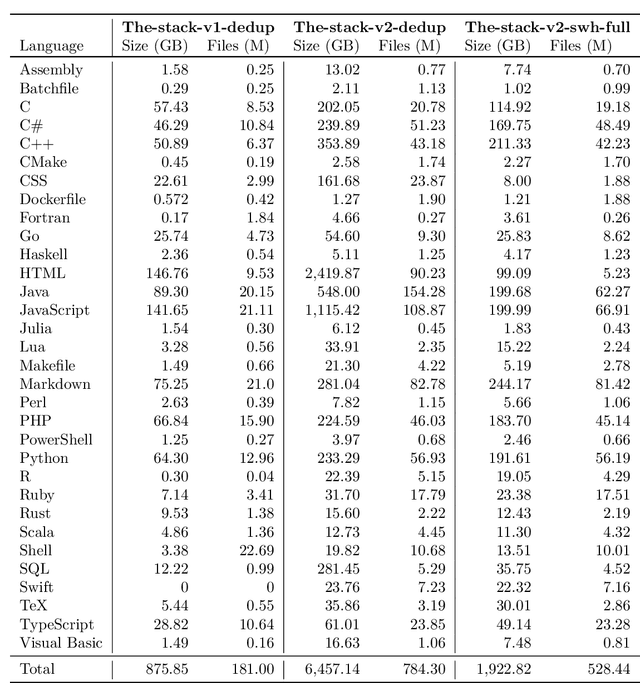
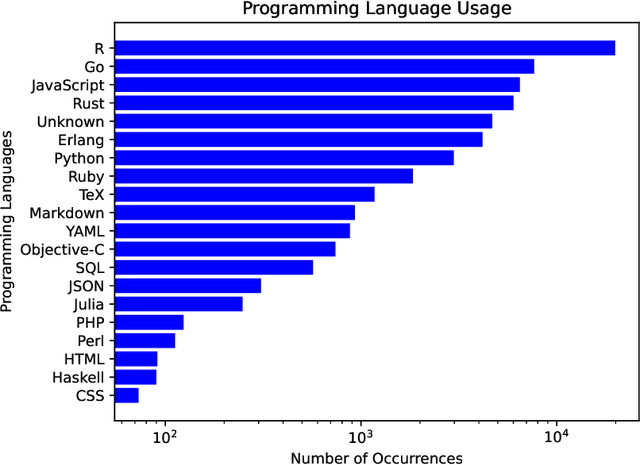
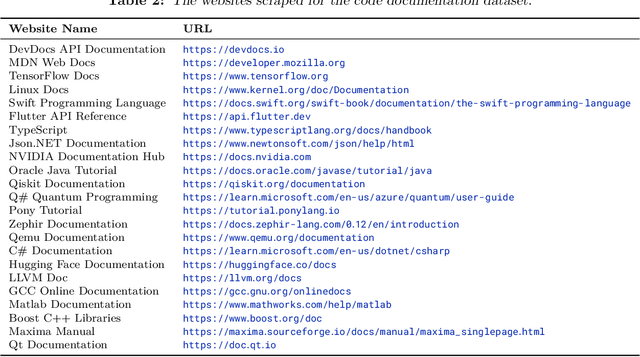
Abstract:The BigCode project, an open-scientific collaboration focused on the responsible development of Large Language Models for Code (Code LLMs), introduces StarCoder2. In partnership with Software Heritage (SWH), we build The Stack v2 on top of the digital commons of their source code archive. Alongside the SWH repositories spanning 619 programming languages, we carefully select other high-quality data sources, such as GitHub pull requests, Kaggle notebooks, and code documentation. This results in a training set that is 4x larger than the first StarCoder dataset. We train StarCoder2 models with 3B, 7B, and 15B parameters on 3.3 to 4.3 trillion tokens and thoroughly evaluate them on a comprehensive set of Code LLM benchmarks. We find that our small model, StarCoder2-3B, outperforms other Code LLMs of similar size on most benchmarks, and also outperforms StarCoderBase-15B. Our large model, StarCoder2- 15B, significantly outperforms other models of comparable size. In addition, it matches or outperforms CodeLlama-34B, a model more than twice its size. Although DeepSeekCoder- 33B is the best-performing model at code completion for high-resource languages, we find that StarCoder2-15B outperforms it on math and code reasoning benchmarks, as well as several low-resource languages. We make the model weights available under an OpenRAIL license and ensure full transparency regarding the training data by releasing the SoftWare Heritage persistent IDentifiers (SWHIDs) of the source code data.
HumanEval-XL: A Multilingual Code Generation Benchmark for Cross-lingual Natural Language Generalization
Feb 26, 2024Abstract:Large language models (LLMs) have made significant progress in generating codes from textual prompts. However, existing benchmarks have mainly concentrated on translating English prompts to multilingual codes or have been constrained to very limited natural languages (NLs). These benchmarks have overlooked the vast landscape of massively multilingual NL to multilingual code, leaving a critical gap in the evaluation of multilingual LLMs. In response, we introduce HumanEval-XL, a massively multilingual code generation benchmark specifically crafted to address this deficiency. HumanEval-XL establishes connections between 23 NLs and 12 programming languages (PLs), and comprises of a collection of 22,080 prompts with an average of 8.33 test cases. By ensuring parallel data across multiple NLs and PLs, HumanEval-XL offers a comprehensive evaluation platform for multilingual LLMs, allowing the assessment of the understanding of different NLs. Our work serves as a pioneering step towards filling the void in evaluating NL generalization in the area of multilingual code generation. We make our evaluation code and data publicly available at \url{https://github.com/FloatAI/HumanEval-XL}.
Tool-Augmented Reward Modeling
Oct 02, 2023



Abstract:Reward modeling (a.k.a., preference modeling) is instrumental for aligning large language models with human preferences, particularly within the context of reinforcement learning from human feedback (RLHF). While conventional reward models (RMs) have exhibited remarkable scalability, they oft struggle with fundamental functionality such as arithmetic computation, code execution, and factual lookup. In this paper, we propose a tool-augmented preference modeling approach, named \name, to address these limitations by empowering RMs with access to external environments, including calculators and search engines. This approach not only fosters synergy between tool utilization and reward grading but also enhances interpretive capacity and scoring reliability. Our study delves into the integration of external tools into RMs, enabling them to interact with diverse external sources and construct task-specific tool engagement and reasoning traces in an autoregressive manner. We validate our approach across a wide range of domains, incorporating seven distinct external tools. Our experimental results demonstrate a noteworthy overall improvement of 17.7% across eight tasks in preference ranking. Furthermore, our approach outperforms Gopher 280B by 7.3% on TruthfulQA task in zero-shot evaluation. In human evaluations, RLHF trained with Themis attains an average win rate of 32% when compared to baselines across four distinct tasks. Additionally, we provide a comprehensive collection of tool-related RM datasets, incorporating data from seven distinct tool APIs, totaling 15,000 instances. We anticipate that this publicly available dataset will facilitate and inspire further research advancements in the field.
Improved Training of Mixture-of-Experts Language GANs
Feb 23, 2023Abstract:Despite the dramatic success in image generation, Generative Adversarial Networks (GANs) still face great challenges in synthesizing sequences of discrete elements, in particular human language. The difficulty in generator training arises from the limited representation capacity and uninformative learning signals obtained from the discriminator. In this work, we (1) first empirically show that the mixture-of-experts approach is able to enhance the representation capacity of the generator for language GANs and (2) harness the Feature Statistics Alignment (FSA) paradigm to render fine-grained learning signals to advance the generator training. Specifically, FSA forces the mean statistics of the distribution of fake data to approach that of real samples as close as possible in the finite-dimensional feature space. Empirical study on synthetic and real benchmarks shows the superior performance in quantitative evaluation and demonstrates the effectiveness of our approach to adversarial text generation.
 Add to Chrome
Add to Chrome Add to Firefox
Add to Firefox Add to Edge
Add to Edge